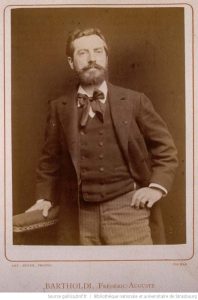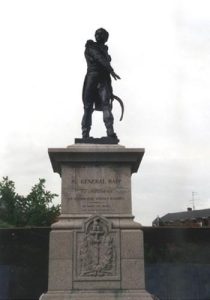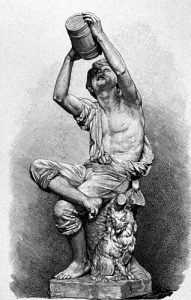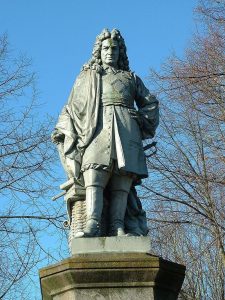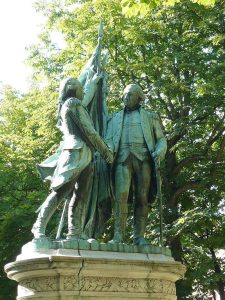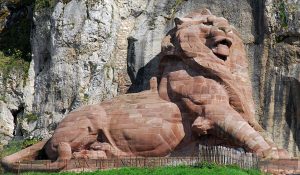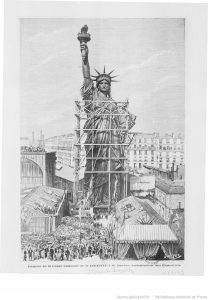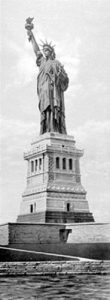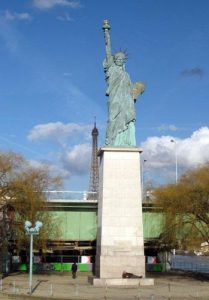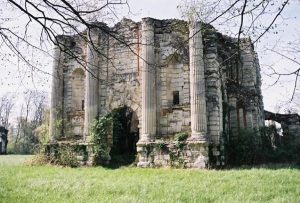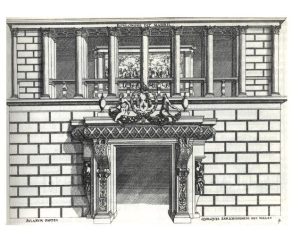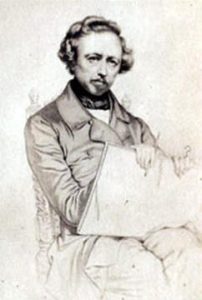His training
Bartholdi spent his childhood in Colmar but was then sent to Paris, where he had relatives, to study at the Lycée Louis-le-Grand (secondary school). He planned to become an architect before turning to painting. He then joined the workshop of Ary Scheffer at the Ecole des Beaux Arts, who advised him to become a sculptor. He studied this art at the studio of Jean-François Soitoux (1816-1891). As early as 1854 Bartholdi took part in a competition, organised by the city of Colmar, entering an imposing statue of Colmar-born General Rapp (1771-1821). Bartholdi’s project was selected and the sculpture shown at the Paris Exposition Universelle in 1855. It was erected in Colmar in 1856 and was an immediate success.
At this time he travelled to Egypt with, particularly, the painter Jean-Léon Gérôme, and then alone to Yemen and Ethiopia. He came back with lots of drawings and photographs, which were to influence his later work. He was particularly charmed by local colossal art that inspired his idea for a lighthouse to mark the entrance of the Suez Canal. It was submitted, but refused by Ferdinand de Lesseps in 1896.
Public commissions
Bartholdi benefitted from many urban regeneration projects undertaken during the Second Empire and Third Republic, producing many huge statues including:
- a statue of General Arrighi de Casanova for Corte (Haute-Corse) in 1868,
- a statue of Vauban at Avallon (Yonne) in 1871,
- an equestrian statue of Vercingetorix in Clermont-Ferrand (Puy de Dôme) – ordered in 1870 but created around 1900,
- a statue of Rouget de Lisle in Lons-le-Saunier (Jura) in 1879,
- a statue of Diderot in Langres (Haute-Marne) in 1884,
- a group showing Washington and La Fayette for Paris in 1892.
Private commissions
Bartholdi also had many private commissions, especially for funeral monuments, (Emile Hubner in Mulhouse Cemetery in 1890). He also took part in the ornamentation of two temples:
- in Boston he designed a project depicting Baptism, Communion, Marriage and Burial; the bas-relief, produced by Italian sculptors, ran along the high part of the First Baptist Church bell tower
- in 1874, at Boissy-Saint-Léger (Val de Marne), he decorated the doorway tympanum of the temple with a high relief representing Faith and Hope.
Bartholdi the architect
Bartholdi was not limited to sculpture and in 1859 he tendered for an urban architectural project in Marseilles, for a water tower and a museum. It was officially selected, but the new local council gave the project to the architect Espérandieu. The latter copied Bartholdi’s project for the Palais Longchamp so accurately that only, after many years, the sculptor won his lawsuit against the city.
An activist artist following the annexation of Alsace
Bartholdi enrolled in the Garde Nationale (National Guard) when war broke out in 1870. First he served in Colmar and became Garibaldi’s aide de camp, then head of the «Armée des Vosges» (“Vosges Army”). The annexation of Alsace by Germany greatly influenced his work:
- the tomb of the national guards in Colmar (Haut-Rhin),
- the scourge of Alsace (a group made of silver and given to Gambetta in 1872),
- Switzerland easing the pains of Strasbourg during the 1870 siege (for the city of Basel in 1895).
To commemorate the heroic resistance of Belfort (Territoire de Belfort – territory of Belfort) during the 1870 war, he offered the city an imposing sculpture, 22 meters long and 11 meters high, inserted in the citadel wall. It was to be in rose sandstone from the Vosges region, and to represent a wounded lion roaring furiously. A downsized model of the Lion de Belfort was cast in bronze to be set in the middle of the Denfert-Rochereau square in Paris, and unveiled in 1880. Last, but not finally least, he created the Monument to the balloonists during the siege of Paris – the famous Ballon des Ternes which was melted by the Germans in 1942.
The Statue of Liberty
After the war of 1870 Bartholdi travelled to the United States with the idea of designing a sculpture to celebrate American Independence. Entering the Bay of New-York on 21 June, 1871, he imagined a colossal statue erected at the harbour entrance: Liberty Enlightening the World.
This work was directly inspired by the project he had designed for Suez. With the help of Gustave Eiffel, for the engineering, Bartholdi designed a 33-meter high statue made of copper strips on a steel structure, set on a 34-meter high pedestal. The statue was produced in Paris and unveiled in New-York in 1886, and gained its maker the title of Citizen of New-York.
The sculpture was soon famous worldwide and many replicas were made in various sizes. One of the most well-known has adorned the downstream end of the «Ile aux Cygnes» (pont de Grenelle) in Paris since 1885. The latest was erected at the North entrance to Colmar, on the hundredth anniversary of Bartholdi’s death.
A patriotic inspiration and sense of the monumental enabled Bartholdi to completely alter the tradition of sculpture in public places.
The house where Bartholdi was born was turned into a museum in 1904. It shows multiple aspects of his work as a sculptor and an architect, as a painter and a designer.

